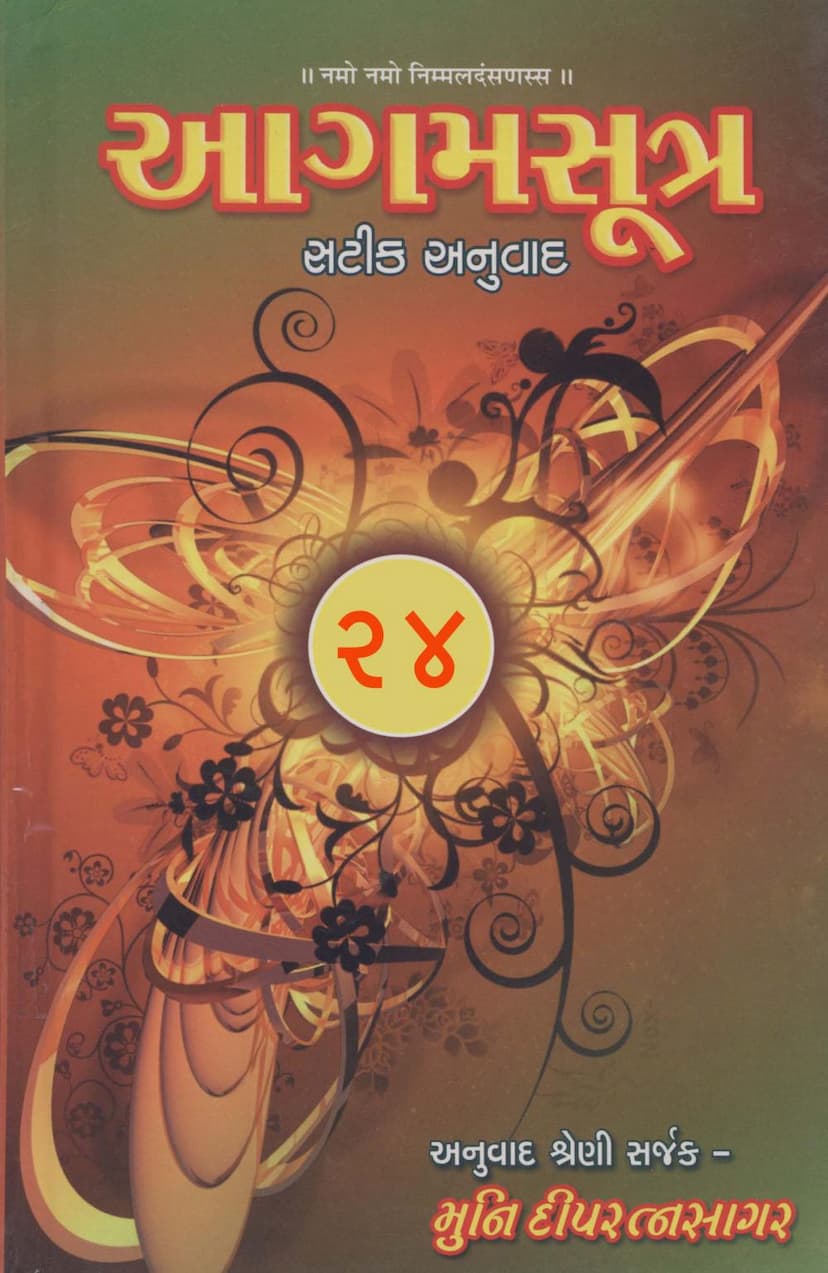Agam Satik Part 24 Chandrapragnpti Sutra Gujarati Anuwad 2
Added to library: September 1, 2025

Summary
Here is a comprehensive summary of the Jain text "Agam Satik Part 24 Chandrapragnpti Sutra Gujarati Anuwad 2":
Book Title: Agam Satik Part 24 Chandrapragnpti Sutra Gujarati Anuwad 2 Author(s): Muni Deepratnasagar, Deepratnasagar Publisher: Deepratnasagar Catalog Link: https://jainqq.org/explore/009015/1
This document is the 24th part of a larger series titled "Agam Sutra Satik Anuwad" (Commented Translation of Agam Sutras), compiled and translated by Muni Deepratnasagar. This specific volume focuses on astrological and cosmological aspects within Jainism, primarily covering the Suryaprajnapti Upanga Sutra (Part 2) and Chandraprajnapti Upanga Sutra.
Key Content and Themes:
- Focus on Celestial Bodies: The primary subject matter is the astronomical knowledge within Jainism, specifically detailing the nature, movements, and characteristics of the Sun (Surya) and Moon (Chandra).
- Suryaprajnapti Upanga Sutra (Part 2): This section of the volume continues the discussion from the previous part, delving deeper into the intricacies of the Sun's movements and influence.
- Chandraprajnapti Upanga Sutra: This section is entirely dedicated to the Moon, its celestial characteristics, its cosmic journey, and its influence. The text notes that while Suryaprajnapti and Chandraprajnapti are considered Upanga Sutras, their exact classification and order are subject to scholarly debate, with no explicit mention in the commentary of P.P. Malaygiri Suri M.S. that they belong to the Anga Sutras. The text also highlights that the current versions of both Sutras are largely identical, with Chandraprajnapti having only three additional introductory verses.
- Detailed Astronomical Calculations and Descriptions: The text engages in detailed discussions of various astronomical concepts, including:
- Months and Years: It elaborates on the names and classifications of months (e.g., Lokika and Lokottara names) and the different types of years (Samvatsara) such as Nakshatra Samvatsara, Yuga Samvatsara, Pramana Samvatsara, Lakshana Samvatsara, and Shanaishchara Samvatsara. The text provides complex calculations regarding the duration of these years in terms of Ahoratra (solar days) and Muhurta (time units).
- Celestial Cycles: It discusses various cycles related to the Sun and Moon, including their positions, conjunctions with constellations, and their influence.
- Conjunctions and Positions: The text meticulously describes how the Moon and Sun interact with constellations at different times of the day and month, calculating the precise periods of these interactions.
- Divine Beings and Vimanas: It references celestial beings (Devas) associated with these celestial bodies, their lifespans, their powers, and the nature of their celestial abodes (Vimanas). It describes the physical characteristics of these Vimanas, emphasizing their jewel-studded and resplendent nature.
- Geographical and Cosmological Framework: The text provides details about the structure of the universe, specifically mentioning Jambudvipa, its dimensions, surrounding oceans (Lavana Samudra), and the concept of chakravāla (circular cosmic boundaries).
- Discrepancies in Beliefs: The text acknowledges and presents differing viewpoints held by various philosophical or religious traditions regarding the nature and existence of celestial bodies and their movements. It contrasts these with the author's understanding, often referencing P.P. Malaygiri Suri's commentary and P.P. Shrutakevali Sagar Nandi Suri's editorial work.
- Mathematical and Astronomical Calculations: A significant portion of the text is dedicated to detailed mathematical calculations, presented in a highly specific and technical manner, likely intended for scholars familiar with Jain astronomical sciences. These calculations involve complex fractions and units of time, such as Ahoratra and Muhurta, to determine celestial positions and cycles.
- Acknowledgement of Donors: The document extensively lists numerous individuals, families, and organizations that financially supported the publication of this series of Agam Sutra translations. This highlights the significant effort and community involvement in making these ancient Jain texts accessible.
- List of Publications: The introductory sections also provide a comprehensive catalog of other published works by Muni Deepratnasagar and the associated organizations, covering various aspects of Jain literature, including Grammar, Commentaries, Tattva Sutras, Aradhana literature, rituals, pujans, and dictionaries related to Agamas. This contextualizes the current volume within a broader corpus of Jain scholarship.
Overall Purpose and Significance:
This volume is a scholarly rendition of ancient Jain astronomical texts, aiming to preserve and disseminate this specific knowledge system. It serves as a resource for understanding Jain cosmology, the detailed workings of celestial bodies as perceived in Jain tradition, and the intricate mathematical and calendrical systems developed within the faith. The detailed commentary and translation by Muni Deepratnasagar aim to make these complex subjects more accessible to Gujarati-speaking readers interested in Jain philosophy and science. The extensive list of acknowledgments emphasizes the collaborative nature of such religious scholarship and publication efforts.